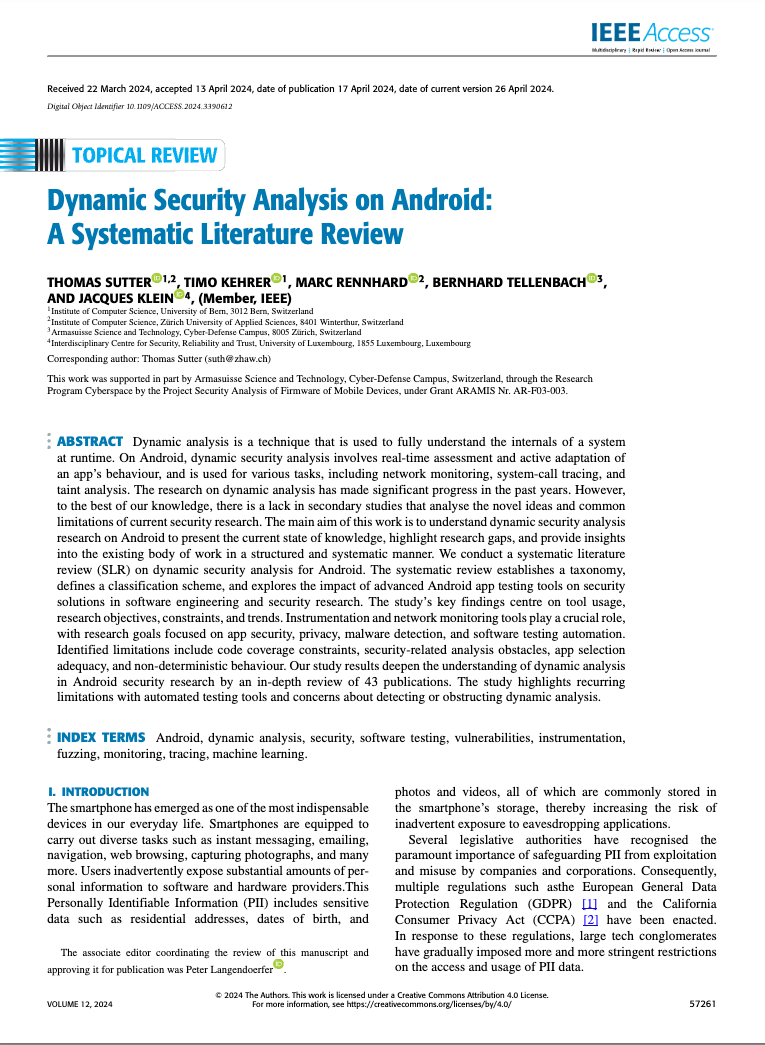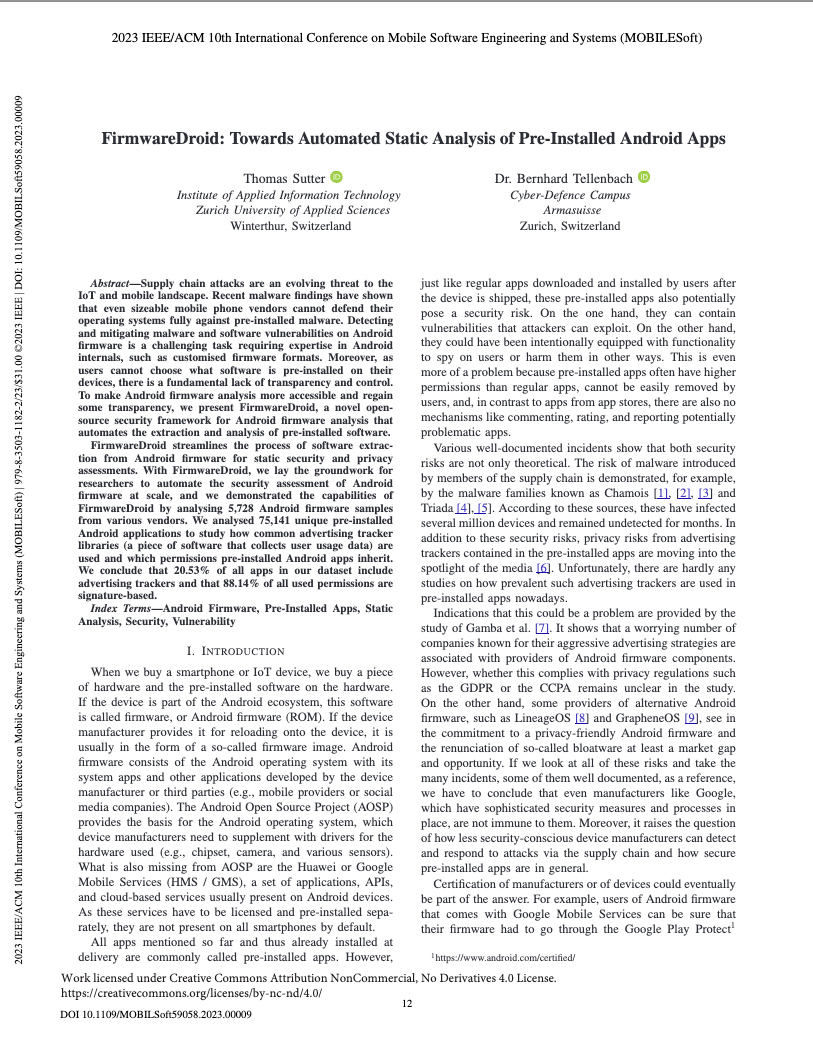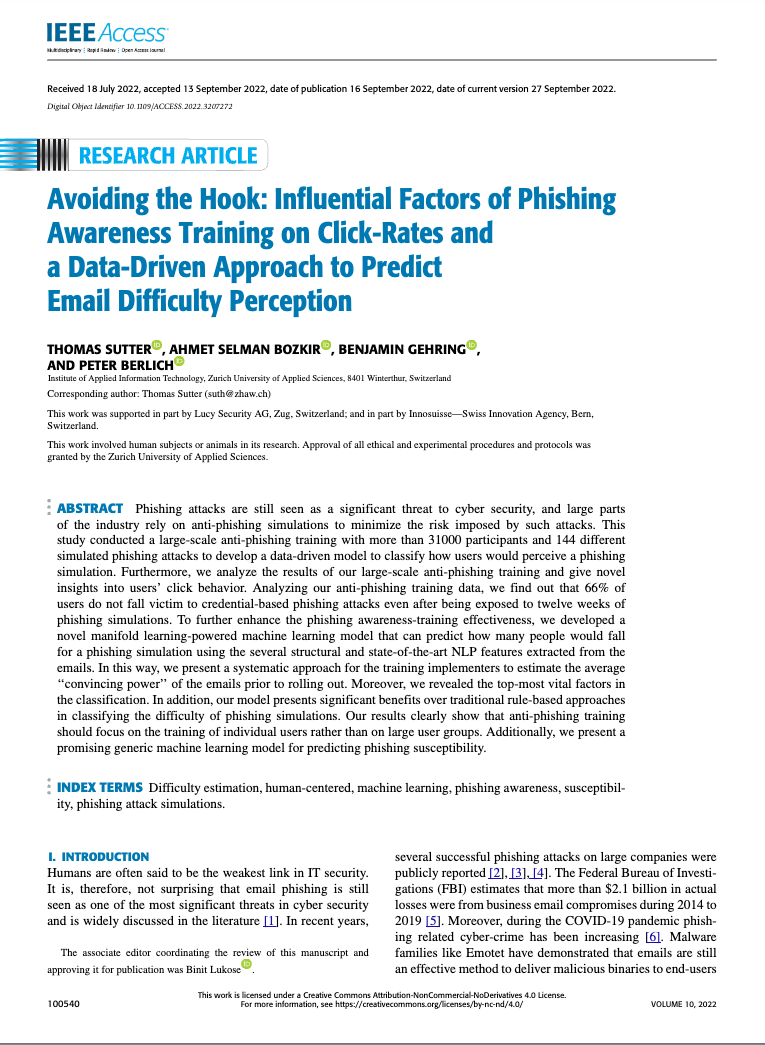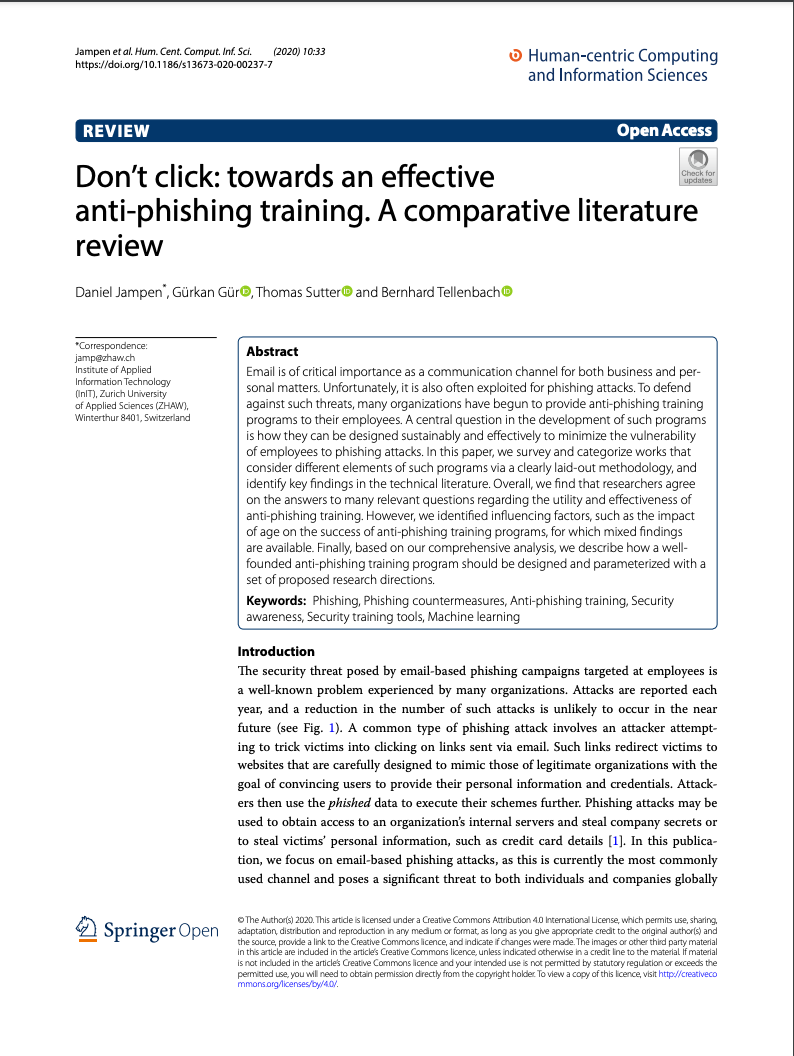Publications
talks and publications by categories in reversed chronological order.
Talks
Some of the talks I’ve given in the past or that are planned:
- OWASP Switzerland Chapter Meeting (2025): Uninstallable by Design: The Role of Pre-installed Apps in Android’s Security Landscape
- IEEE Computer Society, Madras, Computer Security Day (2024): Uninstallable by Design: The Role of Pre-installed Apps in Android’s Security Landscape
- Global Cyber Conference (2023): Avoiding the Hook: Phishing Awareness
- BlackHat Europe (2019): Simple Spyware: Androids Invisible Foreground Services and How to (Ab)use Them
Papers
2024
-
 Dynamic Security Analysis on Android: A Systematic Literature ReviewThomas Sutter, Timo Kehrer, Marc Rennhard, and 2 more authorsIEEE Access, 2024
Dynamic Security Analysis on Android: A Systematic Literature ReviewThomas Sutter, Timo Kehrer, Marc Rennhard, and 2 more authorsIEEE Access, 2024Dynamic analysis is a technique that is used to fully understand the internals of a system at runtime. On Android, dynamic security analysis involves real-time assessment and active adaptation of an app’s behaviour, and is used for various tasks, including network monitoring, system-call tracing, and taint analysis. The research on dynamic analysis has made significant progress in the past years. However, to the best of our knowledge, there is a lack in secondary studies that analyse the novel ideas and common limitations of current security research. The main aim of this work is to understand dynamic security analysis research on Android to present the current state of knowledge, highlight research gaps, and provide insights into the existing body of work in a structured and systematic manner. We conduct a systematic literature review (SLR) on dynamic security analysis for Android. The systematic review establishes a taxonomy, defines a classification scheme, and explores the impact of advanced Android app testing tools on security solutions in software engineering and security research. The study’s key findings centre on tool usage, research objectives, constraints, and trends. Instrumentation and network monitoring tools play a crucial role, with research goals focused on app security, privacy, malware detection, and software testing automation. Identified limitations include code coverage constraints, security-related analysis obstacles, app selection adequacy, and non-deterministic behaviour. Our study results deepen the understanding of dynamic analysis in Android security research by an in-depth review of 43 publications. The study highlights recurring limitations with automated testing tools and concerns about detecting or obstructing dynamic analysis.
@article{10504267, author = {Sutter, Thomas and Kehrer, Timo and Rennhard, Marc and Tellenbach, Bernhard and Klein, Jacques}, journal = {IEEE Access}, title = {Dynamic Security Analysis on Android: A Systematic Literature Review}, year = {2024}, volume = {12}, number = {}, pages = {57261-57287}, keywords = {Security;Codes;Operating systems;Fuzzing;Taxonomy;Systematics;Androids;Software testing;Machine learning;Monitoring;Instrumentation and measurement;Android;dynamic analysis;security;software testing;vulnerabilities;instrumentation;fuzzing;monitoring;tracing;machine learning}, doi = {10.1109/ACCESS.2024.3390612}, url = {https://ieeexplore.ieee.org/abstract/document/10504267}, }
2023
-
 FirmwareDroid: Towards Automated Static Analysis of Pre-Installed Android AppsThomas Sutter, and Bernhard TellenbachIn 2023 IEEE/ACM 10th International Conference on Mobile Software Engineering and Systems (MOBILESoft), 2023
FirmwareDroid: Towards Automated Static Analysis of Pre-Installed Android AppsThomas Sutter, and Bernhard TellenbachIn 2023 IEEE/ACM 10th International Conference on Mobile Software Engineering and Systems (MOBILESoft), 2023Supply chain attacks are an evolving threat to the IoT and mobile landscape. Recent malware findings have shown that even sizeable mobile phone vendors cannot defend their operating systems fully against pre-installed malware. Detecting and mitigating malware and software vulnerabilities on Android firmware is a challenging task requiring expertise in Android internals, such as customised firmware formats. Moreover, as users cannot choose what software is pre-installed on their devices, there is a fundamental lack of transparency and control. To make Android firmware analysis more accessible and regain some transparency, we present FirmwareDroid, a novel open-source security framework for Android firmware analysis that automates the extraction and analysis of pre-installed software.FirmwareDroid streamlines the process of software extraction from Android firmware for static security and privacy assessments. With FirmwareDroid, we lay the groundwork for researchers to automate the security assessment of Android firmware at scale, and we demonstrated the capabilities of FirmwareDroid by analysing 5,728 Android firmware samples from various vendors. We analysed 75,141 unique pre-installed Android applications to study how common advertising tracker libraries (a piece of software that collects user usage data) are used and which permissions pre-installed Android apps inherit. We conclude that 20.53% of all apps in our dataset include advertising trackers and that 88.14% of all used permissions are signature-based.
@inproceedings{10172951, author = {Sutter, Thomas and Tellenbach, Bernhard}, booktitle = {2023 IEEE/ACM 10th International Conference on Mobile Software Engineering and Systems (MOBILESoft)}, title = {FirmwareDroid: Towards Automated Static Analysis of Pre-Installed Android Apps}, year = {2023}, volume = {}, number = {}, pages = {12-22}, keywords = {Privacy;Supply chains;Static analysis;Malware;Security;Advertising;Task analysis;Android Firmware;Pre-Installed Apps;Static Analysis;Security;Vulnerability}, doi = {10.1109/MOBILSoft59058.2023.00009}, url = {https://ieeexplore.ieee.org/abstract/document/10172951}, }
2022
-
 Avoiding the Hook: Influential Factors of Phishing Awareness Training on Click-Rates and a Data-Driven Approach to Predict Email Difficulty PerceptionThomas Sutter, Ahmet Selman Bozkir, Benjamin Gehring, and 1 more authorIEEE Access, 2022
Avoiding the Hook: Influential Factors of Phishing Awareness Training on Click-Rates and a Data-Driven Approach to Predict Email Difficulty PerceptionThomas Sutter, Ahmet Selman Bozkir, Benjamin Gehring, and 1 more authorIEEE Access, 2022Phishing attacks are still seen as a significant threat to cyber security, and large parts of the industry rely on anti-phishing simulations to minimize the risk imposed by such attacks. This study conducted a large-scale anti-phishing training with more than 31000 participants and 144 different simulated phishing attacks to develop a data-driven model to classify how users would perceive a phishing simulation. Furthermore, we analyze the results of our large-scale anti-phishing training and give novel insights into users’ click behavior. Analyzing our anti-phishing training data, we find out that 66% of users do not fall victim to credential-based phishing attacks even after being exposed to twelve weeks of phishing simulations. To further enhance the phishing awareness-training effectiveness, we developed a novel manifold learning-powered machine learning model that can predict how many people would fall for a phishing simulation using the several structural and state-of-the-art NLP features extracted from the emails. In this way, we present a systematic approach for the training implementers to estimate the average “convincing power” of the emails prior to rolling out. Moreover, we revealed the top-most vital factors in the classification. In addition, our model presents significant benefits over traditional rule-based approaches in classifying the difficulty of phishing simulations. Our results clearly show that anti-phishing training should focus on the training of individual users rather than on large user groups. Additionally, we present a promising generic machine learning model for predicting phishing susceptibility.
@article{9893815, author = {Sutter, Thomas and Bozkir, Ahmet Selman and Gehring, Benjamin and Berlich, Peter}, journal = {IEEE Access}, title = {Avoiding the Hook: Influential Factors of Phishing Awareness Training on Click-Rates and a Data-Driven Approach to Predict Email Difficulty Perception}, year = {2022}, volume = {10}, number = {}, pages = {100540-100565}, keywords = {Phishing;Training data;Human factors;Estimation ;Predictive models;Machine learning;Security;Human computer interaction;Difficulty estimation;human-centered;machine learning;phishing awareness;susceptibility;phishing attack simulations}, doi = {10.1109/ACCESS.2022.3207272}, url = {https://ieeexplore.ieee.org/document/9893815}, }
2020
-
 Don’t click: towards an effective anti-phishing training. A comparative literature reviewDaniel Jampen, Gürkan Gür, Thomas Sutter, and 1 more authorHuman-centric Computing and Information Sciences, 2020
Don’t click: towards an effective anti-phishing training. A comparative literature reviewDaniel Jampen, Gürkan Gür, Thomas Sutter, and 1 more authorHuman-centric Computing and Information Sciences, 2020Email is of critical importance as a communication channel for both business and personal matters. Unfortunately, it is also often exploited for phishing attacks. To defend against such threats, many organizations have begun to provide anti-phishing training programs to their employees. A central question in the development of such programs is how they can be designed sustainably and effectively to minimize the vulnerability of employees to phishing attacks. In this paper, we survey and categorize works that consider different elements of such programs via a clearly laid-out methodology, and identify key findings in the technical literature. Overall, we find that researchers agree on the answers to many relevant questions regarding the utility and effectiveness of anti-phishing training. However, we identified influencing factors, such as the impact of age on the success of anti-phishing training programs, for which mixed findings are available. Finally, based on our comprehensive analysis, we describe how a well-founded anti-phishing training program should be designed and parameterized with a set of proposed research directions.
@article{jampen2020don, title = {Don’t click: towards an effective anti-phishing training. A comparative literature review}, author = {Jampen, Daniel and G{\"u}r, G{\"u}rkan and Sutter, Thomas and Tellenbach, Bernhard}, journal = {Human-centric Computing and Information Sciences}, volume = {10}, number = {1}, pages = {33}, year = {2020}, publisher = {Springer}, url = {https://link.springer.com/article/10.1186/s13673-020-00237-7}, }



